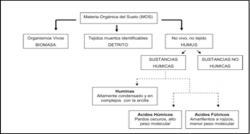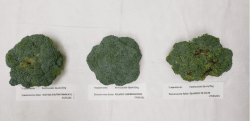What are acids?
First of all, it is very important to understand what acids are, both humic and fulvic, since their presence in our crops’ soil, is vital for its development.
These are complex macro-molecular groupings in which the fundamental units are phenolic aromatic compounds, derived from the decomposition of the organic matter present in the soil; as well as nitrogenous compounds, both cyclic and aliphatic synthesized by microorganisms in the soil.
The origin of Humic and Fulvic Acids can be derived from various sources, mainly from the decomposition of peat and plant remains, but the most important is derived from Leonardite (an ideal fertilizer for agricultural crops).
The humus is formed by two acids: Humic and Fulvic; the main difference between the two is their behavior in acidic solutions: Humic Acids are not soluble in basic solutions and for this reason they precipitate, while Fulvic Acids remain soluble all the time.

Classification of Soil Organic Matter Components:: physical and chemical criteria.
Source: Brady & Weil 2002
The main contributions of humic substances are as follows:
Physical:
- They improve the soil structure, forming aggregates that are much more stable.
- They Increase moisture retention.
- They Increase soil temperature.
- They prevent soil erosion by way of surface runoff, by favoring water infiltration (greater porosity and permeability).
Chemical:
- Increases the CIC (Cationic Exchange) which provides greater Phosphorus availability for plants.
- Increases buffer capacity (neutralizing effect).
- They favor micronutrient availability due to their chelating or complexing action.
- They solubilize mineral nutrients by way of the action of carbonic gas that is released by its degradation.
Biological:
- Carbohydrate source for microorganisms
- They favor the natural cycles of the microflora and microfauna
Another difference in addition to the solubility in acidic solutions, is the responsiveness; in the case of Humic Acids, their actions are slower and more durable, especially in soil structure and plant reaction. In the case of Fulvic Acids, plant actions are much faster and less durable.
At MYCSA AG experimental field we observed such reactions when applying Fulvic Acids in Foliar treatment; in Broccoli (Brassica Oleracea) Imperial variety of the Johnny Seeds brand, plants treated with Fulvic Acid showed resistance to MILDIU (Downy Mildew), demonstrating that good nutrition and disease resistance are derived from an adequate absorption of minerals from the soil.
These are reflected in the high quality and supply of broccoli.

Photography Owned by MYCSA AG
At MYCSA AG, all of our products, such as Fulvic Acid andHumic Acid, are professionally pre-tested in order to provide you with the best quality of organic supplies for the optimal benefit of your crops. Would you like to check them out? Find them on our website.
Bibliography
- Cerisola, C. 2015 Edaphic Soil Organic Matter, Management and Conservation
- Ramos, R. 2000, application of commercial humic substances as bio stimulant products.
- https://www.acidoshumicos.com/los-acidos-humicos-y-acidos-fulvicos/
- https://www.fertibox.net/single-post/aciof the

